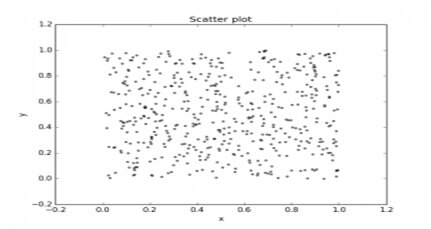

Resize and align your graph and export it for use on the web or in print. Matplotlib even gives you a simple way to tweak and export the graph as an image using the buttons at the bottom of the window. Simple! And Matplotlib has done most of the legwork for us.
Scatter plot matplotlib example code#
Save the above code in the file scatter.py, and run it using: python3 scatter.py Making Scatter Plots with Python! # Plot colour, shapes, etc will all be the default Y = (numberOfPoints)# Generate list of random Y coordinates X = (numberOfPoints) # Generate list of random X coordinates NumberOfPoints = 200 # The number of points we want to plot # The x and y coordinates will be paired based on their corresponding position in each list
Scatter plot matplotlib example how to#
Here’s how to install Pip! Make a Simple Scatter Plot in Python # Import dependencies NumPy is also installed – it’ll be used to generate some random number sets to plot. Install Python Dependenciesįirst, you’ll need to install MatplotLib using the pip Python package manager. This article will give you a jump-start on using Matplotlib to create scatter plots. What is matplotlib? I’ll let them introduce themselves in their own words: Matplotlib is a comprehensive library for creating static, animated, and interactive visualizations in Python. This tutorial explains exactly how to do so. The best (and easiest!) way to create graphs and scatter plots in Python is using the package Matplotlib. If you disagree, you probably shouldn’t read on. You may make scatter plots that properly depict your data and are both aesthetically pleasing and instructive by using the procedures illustrated above.Graphs are awesome. The ax.annotate() method in Matplotlib makes it simple to add annotations by allowing us to annotate particular data points with text and arrows. ConclusionĪnnotating scatter plots makes them easier to analyze and helps us quickly recognise and comprehend certain points of interest. Moreover, they can include extra details about the data, such labels or values. The plt.show() method will then be used to display the plot together with the annotations.Īnnotations are immensely helpful tools that may be used to draw attention to particular data points, such as outliers, groups of points, or significant values. We'll also change the plot layout by including a title and axis labels to be sure our scatter plot is both aesthetically attractive and understandable. Three annotations will be added in this specific example, each with a distinct arrow color and text placement. Upon completion of that, we can use the ax.annotate() function to annotate particular data points on the plot. Use the ax.scatter() method to build a scatter plot. Next, two arrays of x and y randomly chosen data points are created for plotting.

We import the two required libraries, Matplotlib and NumPy, into the code.

# Adjust the annotation formatting as needed # Define the scatter plot using Matplotlib Example AlgorithmĪdd annotations to specific data points using text or arrow annotationsĪdjust the annotation formatting as needed Note − ax in the above syntax is the Axes object that is returned when creating a scatter plot in Matplotlib.

**kwargs − Additional keyword arguments to be passed to the Text constructor. Some commonly used properties include facecolor, edgecolor, arrowstyle, shrink, and width. It specifies the style and color of the arrow connecting the text and the annotated point. If None (default), xy is used as the text location.Īrrowprops − A dictionary of arrow properties. Xytext − (x,y) coordinates of the text annotation. Xy − (x,y) coordinates of the point to annotate. Text − Text to be displayed in the annotation. Syntax ax.annotate(text, xy, xytext=None, arrowprops=None, **kwargs) In order to make Matplotlib scatter plots more understandable, this article will examine how to annotate them. If comments are made, some points of interest in a scatter plot could be easier to observe and understand. Yet, scatter charts can also be hard to interpret when there are numerous data points. They help us identify potential anomalies, patterns, and trends in the data. Scatter plots are an essential tool for illustrating the connection between two continuous variables.


 0 kommentar(er)
0 kommentar(er)
